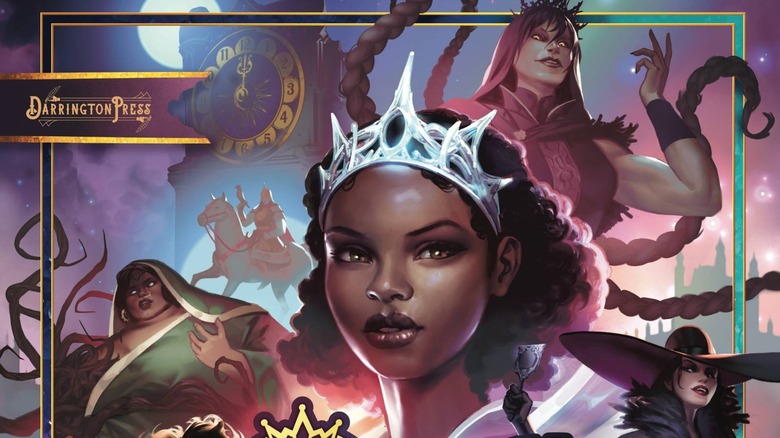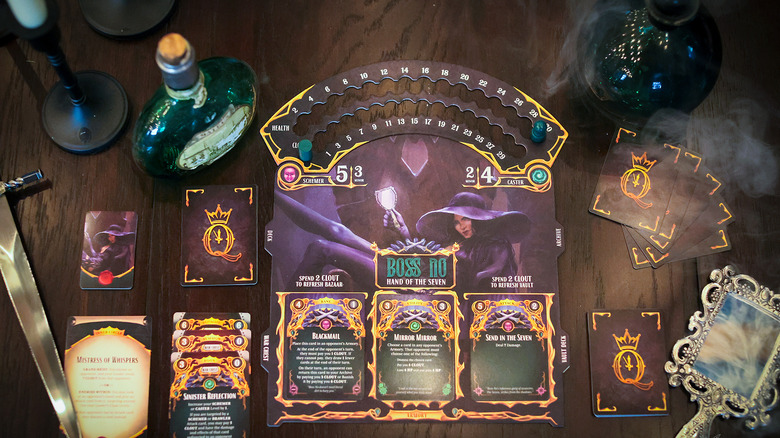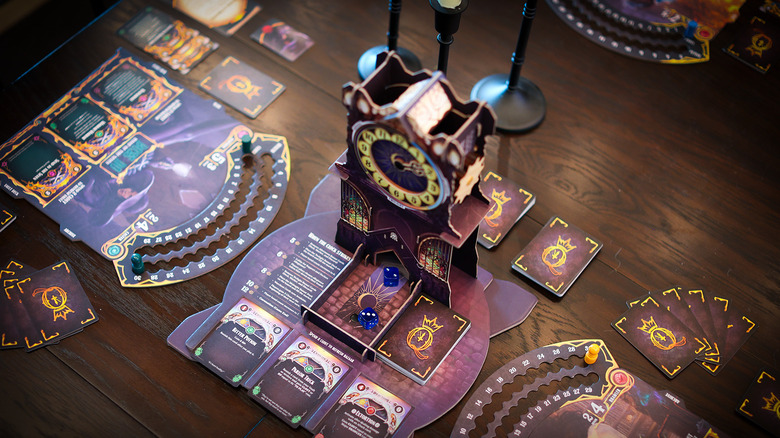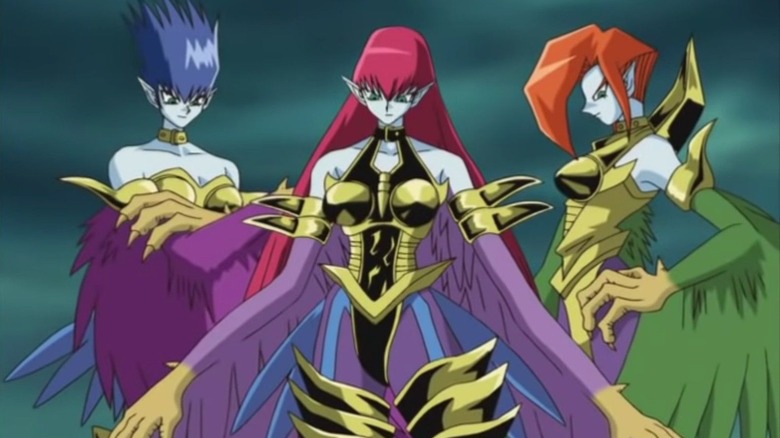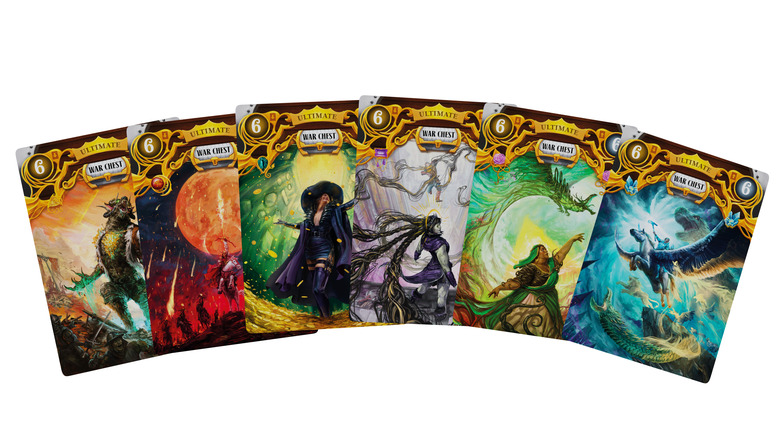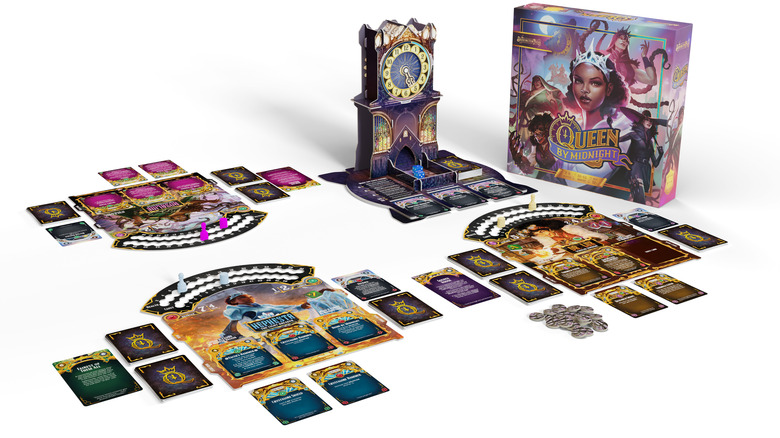Queen By Midnight: How Critical Role & Yu-Gi-Oh! Helped Kyle Shire Build A Gaming Hit - Exclusive Interview
Rather than watch the battle of good versus evil on a screen while venturing into far-off lands with fanciful characters, you and your friends can partake in the adventure yourself. There's no shortage of incredible board games out there, and Darrington Press has just introduced a new one that's already proven to be a big hit among fantasy fans.
"Queen by Midnight" is a fantastic deck-building board game that has you assume the role of a princess. After the death of the Midnight Queen, the Princesses of the Twelve Lands engage in the Rule By Midnight, which sees them battle and scheme against one another for a chance to become the new Midnight Queen. You'll have to use all the power and deception at your disposal by playing the right cards to declare victory. And the game differentiates itself from others with an intricate Dice Clock Tower at the center of the table to really make a lasting impression.
It's the first game designed by "Critical Role" producer Kyle Shire. He's intricately familiar with the lore of "Dungeons & Dragons," but he's created a whole new world with "Queen by Midnight." In an exclusive interview with Looper, he spoke about the design process and what budding gamers can expect from the game that's sure to become a centerpiece of any collection.
All the hard work paid off
"Queen by Midnight" made a big splash at GenCon and sold out every day within the first 15 minutes. How exciting was that for you to work on a game for so long and then have it receive such an enthusiastic response?
Oh my gosh, out of this world. It was incredible to see people get really excited about it. I was expecting it to do well, but I wasn't expecting hype over it. In the truest sense, coming from a brand like Darrington Press, which publishes a lot of stuff with an IP that people are very used to, to bring something new to the table that is disconnected from that — I was expecting it to do well, but I wasn't expecting it to grab people the way that it did, and I'm so glad that it did.
Look at how beautiful that box is. The people who went into making that hit it out of the park. In retrospect, I'm like, "Of course it did," but in the moment I was like, "What is going on? This is out of this world."
Can you talk about how the game came to be? How long has it been in the works, and how did you find the time to make it while balancing your "Critical Role" duties?
The simple answer is I did not. I was working for a company that got dissolved in early 2019, and I was really aimless and rudderless. I had this game idea on the back burner for a while that I had gingerly entertained and was initially thinking, "Maybe it could be a fighting game." A really good close friend of mine who makes video games was like, "Hey, do you know anything about making video games?" I was like, "No." He's like, "Then don't make it." He knew that I was into card games, so he was able to convince me that making it into a deck-building game would make a lot of sense.
I absolutely love deck-building games. Figuring out how this game would translate into it became my reason to get up in the morning for a very long time while I was riding the funemployment train pretty much for all of 2019. You asked how I found the time. I had a lot of it during that. I didn't do much other than work on that game and apply for jobs and do little survival gigs here and there. When I got my job at CR in December of 2019, I was like, "Okay, it's been a lot of fun working on this game. It's going to go sit on the back burner and maybe, someday down the line, I'll be able to do something with it." Not a lot happened with it for [over] a year.
I was still finding some time to play test it with some friends here and there and maybe work on it mildly over the weekends, but it still wasn't evolving or doing anything. When Darrington Press became a thing, that was when I worked up the courage to eventually ask Ivan [Van Norman] to watch a playtest. I wasn't even hard pitching Ivan on publishing it through Darrington Press. I wanted his thoughts on it, because he's a game designer that I respect, and I wanted his thoughts on something that I had made from the ground up. The rest is history, as far as that goes.
I did some work on it after Ivan had seen it and we were trying to figure out, "How do we shift it around so that it can become something even more special than it already is?" For example, the game for the longest time was called "Princess Brawl." It was with Ivan that I was like, "Actually, no, I think it's got to be Queen by Midnight." Working with him to find the tone and the balance between the really fun, fantastical, epic battle that I wanted to tell while also keeping some of my silly references throughout the game, that was where a lot of my work went in after.
Learning from Critical Role to complete Queen by Midnight
There are a lot of folklore and fairytale influences in the game. Was there anything else, either other games or other pieces of media, you looked toward for inspiration when designing the aesthetic of "Queen by Midnight?"
There are some pretty obvious pieces of fairytale folklore in there that you can pick up and tinker around with. Some of my favorite things and pieces to integrate came in the secondary phase where I was trying to figure out, "Who are these princesses as characters?"
That was when I realized I was drawing upon so many of my favorite heroines from comic books and movies. For example, Boss No is very much a cipher for Snow White, but there is a lot of Emma Frost, who's one of my favorite comic characters of all time, as well as a little bit of Carmen Sandiego and a little bit of Selina Kyle from "Batman." Trying to figure out ways to integrate those ideas in ways that are interesting and new that also feel narratively motivated was a lot of fun.
Producing "Critical Role," you obviously know your way around games. Did anything from "Critical Role" influence how you designed "Queen by Midnight," either in terms of the gameplay or even just finding a way to get it made in the first place?
One thing that I learned producing at "Critical Role" that helped me as far as making this game is concerned was learning when to set people up for success and get out of their way. Honing that skill of trusting professionals who are really good at what they do and trusting that they have the best interests of the game at heart when they're making decisions that you may not have even considered is paramount to making something good because nobody is a monolith. It's important that you check your ego at the door, especially when it's something that you've made and you may not be thinking ... When it's something that's really close to you and you've birthed it into the world, it can be very easy to be like, "No, it has to be this way because I made it this way."
That's not a recipe for making something good. It's a recipe for making something that's true to you, but it's not necessarily the key to making something that's really good because you are denying the best parts of other people's artistic voices into your project. When you work in production, you realize that it's a chorus line, and everybody has to be working in unison to make something beautiful. It's not a solo act. Game design is very similar in that regard. I wish I could say that I did everything in-house, like I was a little fairy knocker, diligently drawing everything. I could not have imagined a level of beauty and attention to detail and great ideas that have been put into this by other people.
The influence of Yu-Gi-Oh! on Queen by Midnight
I saw in a separate interview that you are a fan of "Yu-Gi-Oh!" Do you have a favorite card?
I love "Yu-Gi-Oh!" because it was a first introduction into the idea of ludonarrative in game design where seeing the commingling of a narrative and game mechanics into one. I was a little disappointed as a little kid when I went from watching the show to playing the game, and I realized that none of that really matters because the game and the show are very separate and evolved in separate ways.
One thing that I love from the show that I never got to perfect as a player was a full-on Harpie Lady deck, because Mai Valentine was an icon. By watching "Yu-Gi-Oh!," watching Mai Valentine, I was like, "That's the one I want." I loved the idea of a full-on Harpie deck with magical armored accessories and whips, and they got a pet dragon. I love that stuff so much.
With "Yu-Gi-Oh!," did you take anything as inspiration there? There are a lot of badass women designs like the Harpie Ladies or cool magic-esque cards in "Queen by Midnight." Was there any overlap there?
The biggest thing for me, and there are other card games that do this as well, but I love the idea of laying down a trap, like laying something face down and not saying what it is and letting that ambiguity simmer with the rest of your opponents. In the beginning of "Queen by Midnight," everybody's got a card, but as the game progresses and you get more of those reaction cards, you can place face down and wait for the right moment to strike. I really dig that kind of reveal. Us gays, we love a good reveal, okay? There's nothing better than a good "You just activated my trap card" moment.
Incorporating comedy into Queen by Midnight
You also have a history in stand-up comedy. Were you tempted to add inside jokes or Easter eggs for people to catch? Some of the cards have these little quotes at the bottom. Was there a line you wanted to put in there but had to pull back a little, anything like that?
Yeah, this was when Ivan and I were trying to figure out the tone of the game. I was like, "I really want to keep some of these. I want to reserve the right to have some of these flavor texts be funny because they mean a lot to me." The idea of flavor text in general rings true to me as a comedian because it is a subtle, optional punchline for a card if you do it in the right way. Even "Magic the Gathering" does really incredible flavor text every now and then that is very subtly funny at times.
Some of my favorites are subtle quotes that are references to some of my favorite movies. Curse, for example, has an "Addams Family Values" reference. There's a "Clue" reference in Boss No, in her body double card in her war chest that says, "Body doubles should be like tissues: Soft, strong, and disposable," which is one of my favorite Mrs. White quotes. There's also a little bit of Madeline Kahn in Boss No as well.
Another one of my favorites is, in the Midnight Bazaar, there's a card called It's a Bomb, which is twofold. One: it's a reference to "Addams Family Values" when Uncle Fester goes, "It's a bomb." The flavor text is, "You want to get nuts? Let's get nuts," which is from one of the best scenes in the original 1989 "Batman."
What would you say was the most challenging part of the process of bringing "Queen by Midnight" to life?
The most difficult aspect of creating "Queen by Midnight" was those first couple months where I was making it in my North Hollywood apartment, chain-smoking on the balcony, absolutely convinced that nobody was ever going to care about this game and that I was completely wasting my time doing it. [I had to] to tell myself over and over again, "There is a distinct possibility that you are going to work really hard on this game and it's not going to matter to your career to anybody." There is that possibility, and you have to live with that. That doesn't mean that it's not worth doing.
I had that tug of war with myself every single day that I would get up to work on my game, because I had a routine where I would get up in the morning, I would make my coffee, make my breakfast, work out, work on my game for about three hours, and then I would apply for jobs unless I had a job that day, then I would do the job first and then do all of that at night. I was still working on the game consistently every day, but [also] finding the drive to bear down and finish it out and to make something that is serviceable, and accepting the fact that it's not going to be 100% perfect. What matters is that people see what you're trying to do and can offer help how they can.
I'm grateful for everything that Ivan Van Norman was able to do for me and for this game. I do not think that it would have happened if I had not "come correct." As Chetney Pock O'Pea would say, "Come correct or get corrected." I do believe that in that moment. I'm proud to say that I came correct that day, because if I had been a mess, if my game had not been play-tested, if it had been a big wash, someone like Ivan would've been like, "Hey, good work. Keep going. I'm really happy that you're doing this." He would've peaced, and he would've been very polite about it. I'm grateful that I was able to push through that, because that inner saboteur is devious at times.
Advice for other budding game developers
Going off that, a lot of people, I'm sure, deal with being on funemployment, or if they have a job, doing their day job while having whatever creative passion project they want to do, whether it's designing a game, working on music, writing a screenplay, whatever. Would you have any advice for those people on maintaining the motivation to see the passion projects through? As you said, there's no guarantee of success, but you have to do it even if it's during those times when it's a little more difficult.
The most important thing is, first of all, making sure that you are making something that you would want to buy or read or watch — making sure that you are the target audience first, to a degree, and then figuring out what other audience members you can bring in a reasonable manner, and being realistic about that, because you absolutely can make something that you are not enthusiastic about. There are writers and directors and performers that do that in this town every single day. They are also probably writers, actors, and performers who are getting paid pretty well and consistently to do that. When you are making something that you do not have a guarantee of success or even a guarantee of a paycheck with, it is so important that you make sure that you love it first, because you are going to be the first person to love this thing, and it's important that you do what you can to nurture it, like how you would a loved one.
I very well could have been like, "I don't know about having Darrington Press publish this. I'm going to self-publish it, or I'm going to do X, Y, and Z." I had to check myself in that moment, because this game had done so much for me emotionally as a concept. It shepherded me out of a bad place in my life, and I could have had it sit in Google Drive for another three years. Nothing would've happened with it, and I would not have been doing right by this game for doing that. By giving it to these people who were able to bring in some of the most talented, kindhearted, hardworking artists and game designers and producers out there, I did right by the game, and that's because I loved it. Make sure that you love it, because if you don't, you're probably not going to be able to maintain the steam when you're sitting there chain-smoking on your North Hollywood balcony, looking over spreadsheets going, "How do I make the wind conditions of this character feel more epic?"
For anyone who might be on the fence about buying "Queen by Midnight," what would be your pitch to convince them to pick it up and give it a shot with their friends?
If you are on the fence about purchasing "Queen by Midnight," odds are you probably have never played a deck-building game before, because if you have played a deck-building game before, then you're probably already super on board. If you haven't played a deck-building game before, "Queen by Midnight" has an exceptionally low barrier of entry for new deck-building players. I have seen a great deal of people, who have never played a deck-building game before, pick this game up, and by round three they're like, "Oh my God, I need to play this again." As we all know with deck builders, those first couple rounds can set the tone for how well you're going to do. I have seen people pick it up very easily with this game. If you're able to get this, then you can get a lot of other deck builders out there, and you might open yourself up to a whole new genre of game that you never knew was that lovely.
"Queen By Midnight" is available now at the Critical Role online store and at Darrington Press Guild Stores.
This interview has been edited for clarity.
